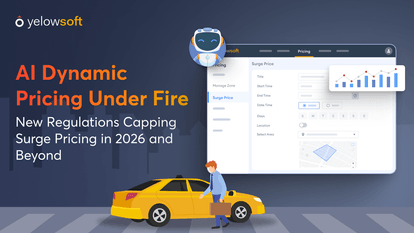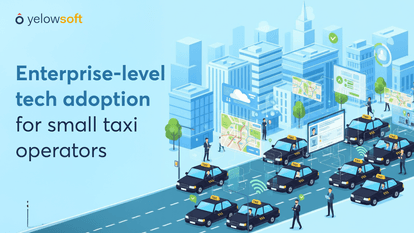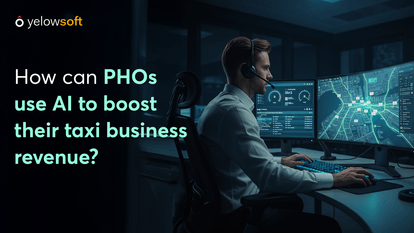Every fleet business has one silent killer. It’s not fuel prices or vehicle wear. It’s an imbalance: the gap between idle cars and overloaded drivers.
On one end, you’ve got cars sitting in parking lots, burning money in insurance and depreciation. On the other hand, drivers are running double shifts, tired and frustrated.
The worst part is that both problems come from the same root cause: “Uneven Scheduling.”
This imbalance doesn’t always show up on your balance sheet. But it slowly eats away at your revenue, morale, and customer trust.
Let’s take a data-driven look at what’s really draining your fleet’s efficiency and how a smarter, analytics-based fleet management system can turn that around.
Let’s begin with understanding the challenges of uneven fleet scheduling.
The Uneven Fleet Scheduling Problem
Most fleet operators don’t realize they’re running two businesses inside one.
One side looks hyperactive: drivers hustling nonstop, vehicles booked to the brim. The other side? Cars idle, drivers waiting endlessly for trips.
That uneven load is costing you not just in missed trips, but in wasted time, high turnover, and declining performance.
When 20% of drivers handle 60% of rides, you don’t have a productivity issue; you have a scheduling blind spot.
Plus, dispatchers depend on instinct or driver availability, not data. And that guesswork creates invisible waste.
Uneven scheduling often means:
- Idle assets during peak hours
- Overworked drivers missing breaks
- Customers waiting longer for rides
- Lost trust in your service reliability
In short, you’re paying for both underuse and overuse, the worst of both worlds.
The Cost of Idle Cars
Idle cars might look harmless. After all, they’re just parked, right? But every parked car burns money quietly. Here’s the cost of idle cars:
1. Fixed Costs That Don’t Stop When Cars Do
Every vehicle has ongoing expenses whether it moves or not: insurance, EMI, taxes, licensing, and depreciation. These costs don’t stop just because the car does.
Let’s say, if a 100-car fleet has 20 cars sitting idle for half the day, and each vehicle costs about $1,200 a month in fixed expenses, you’re burning through $24,000 monthly on underused assets.
That’s money burnt for nothing, literally.
2. Missed Revenue Opportunities
Every idle car represents a missed chance to earn.
Say the average trip brings in $25, and an idle vehicle could’ve handled 10 more trips daily. That’s $250 per day per car.
Multiply that by 20 idle cars, and you’re looking at a $5,000 daily revenue hole.
Over a month? That’s six figures gone. Not because business is bad, but because your scheduling is.
3. Poor Fleet Utilization Metrics
When you pull your Trip Productivity Report, you’ll see it right away: utilization gaps.
If your vehicles are below 70% utilization, your operation isn’t efficient.
The right fleet management system can automatically surface this data and help you rebalance your assets before losses pile up.
4. Brand Impact and Customer Experience
Idle cars mean longer wait times and fewer available drivers during peak hours. Your riders don’t know (or care) that 10 other cars are free in another zone. They just see your app saying, “No cars available.”
And once they move to a competitor’s app, getting them back is twice as hard.
The Cost of Overloaded Drivers
Now let’s look at the other end of the spectrum: your most active drivers. They’re logging endless trips, skipping breaks, and covering for underperformers.
This might seem like “good business” at first glance. After all, more trips mean more money, right?
Wrong. Overloading your top drivers leads to long-term damage that outweighs any short-term gain.
Here’s an overview:
1. Driver Fatigue and Safety Risks
Driver fatigue is a business risk. A tired driver reacts more slowly, misses cues, and is statistically more likely to cause accidents.
And one incident can lead to insurance hikes, downtime, and even legal claims.
Even before that point, fatigue affects behavior and causes short tempers, missed pickups, and slower routes.
Your driver performance monitoring data will show it long before you see it in ratings.
2. Declining Service Quality
Overloaded drivers tend to rush rides. They might skip pre-trip checks or push through exhaustion just to hit targets.
And your customers can tell. They rate lower, complain more, and churn faster.
If your driver performance reports show inconsistent service scores from top-performing drivers, that’s burnout waving a red flag.
3. High Turnover and Recruitment Costs
Driver burnout leads to exits, and replacing these drivers isn’t cheap.
Plus, recruitment, onboarding, and training can easily cost you $2,000–$3,000 per new hire.
And if your turnover spikes even by 10 drivers a year, that’s a $30,000 expense you didn’t budget for.
All because a few drivers carried too much of the load.
4. Revenue Paradox: More Work, Less Profit
Here’s the irony: the busier your best drivers are, the less profitable each trip becomes.
When drivers take back-to-back trips with no route optimization or rest time, fuel usage increases, and efficiency drops.
Your trip productivity report might show more rides, but lower revenue per trip.
That’s not growth. That’s overextension.
Why Uneven Scheduling Happens
Here’s the truth: uneven scheduling isn’t always poor management; it’s a lack of visibility.
Dispatchers often juggle dozens of cars manually. They can’t track live demand spikes or anticipate next-hour peaks.
But without visibility into overall load, zone demand, or idle distribution, even experienced dispatchers can’t balance the system.
Common causes of uneven scheduling include:
Manual trip allocation
- Lack of demand prediction tools
- Dispatcher bias (“Let’s assign it to Alex; he’s fast”)
- No driver performance monitoring dashboard
- Zero visibility on underperforming vehicles
In short, it’s not human error but human limitation.
Humans can’t process data across 100+ vehicles every few seconds. That’s why the smartest fleets now rely on predictive analytics within their fleet management system.
How Analytics Solves the Scheduling Imbalance
Modern fleet management systems can detect and correct imbalance automatically using data analytics and not assumptions.
It studies driver patterns, passenger trends, weather, and past trip data to allocate rides intelligently.
Here’s how it works.
1. Predictive Dispatch Analytics
Predictive dispatching uses AI to forecast demand zones based on patterns like weather, time of day, events, airport schedules, and even past booking data.
So instead of waiting for orders to pile up, the system pre-positions cars where demand will rise.
The result?
- Idle time down by up to 30%
- Driver workload evenly spread
- Faster ETAs and happier riders
Predictive analytics turns dispatching from reaction to foresight.
Pro tip: This also improves your trip productivity report: more balanced trips, more consistent revenue.
2. Heatmaps and Demand Forecasting
Heatmaps turn data into visuals your dispatchers can actually act on. You can instantly see which zones are heating up and where vehicles are underused. And drivers can be repositioned proactively, while ensuring every car is working efficiently.
This single feature can cut empty return trips and balance workloads dramatically.
3. Automated Scheduling and Load Balancing
Automated scheduling ensures every trip gets assigned to the most optimal driver, thereby factoring in:
- Distance from pickup
- Current workload
- Driver’s performance rating, and
- Vehicle availability
It’s fair, fast, and fatigue-free. Plus, it’s smart load balancing at work.
This way:
- Every driver gets fair opportunities.
- Every car stays active.
- Every customer gets a faster ride.
That’s a win-win worth driving toward.
4. Driver Performance Monitoring
With driver performance monitoring, you can track:
- Average trip completion time
- Acceptance and cancellation rate
- Fuel usage per mile
- Customer feedback scores
With this data, you can spot who’s struggling and who’s excelling. You can reward your top performers and support drivers who need help.
Over time, performance improves across the board, without resentment or guesswork.
5. Smart Reporting for Decision-Makers
At the end of the day, leadership needs clarity, not complexity.
The best systems provide visual summaries that make sense instantly:
- The Driver Performance Report highlights who’s excelling and who needs help.
- The Trip Productivity Report shows how efficiently vehicles are utilized.
- The Fleet Utilization Dashboard displays idle ratios, zone balance, and workload trends.
These reports make it easy to connect operational decisions with financial outcomes.
Conclusion
Fleet management is all about balance between cars that move and drivers who don’t burn out.
Too many idle vehicles mean lost revenue, and too much pressure on a few drivers leads to burnout and churn. Both quietly chip away at your profits.
But it doesn’t have to stay that way. When you use real-time analytics to track performance, productivity, and scheduling gaps, balance becomes easy to maintain. You see what’s working, what’s wasting money, and where to act before problems grow.
That’s exactly what Yelowsoft’s taxi dispatch software helps you achieve. Its predictive dispatch analytics and driver performance Insights give you control over what used to feel unpredictable, from trip volumes to workload balance. This way, your drivers stay motivated, your cars stay active, and your business stays profitable.
Discover how Yelowsoft’s Fleet Management System helps you balance drivers, maximize efficiency, and grow revenue.
FAQs
It’s a data summary showing each driver’s efficiency, productivity, and customer feedback, which helps you identify training needs and reward top performers.
It forecasts demand and assigns drivers to high-demand areas ahead of time, thereby cutting idle time by up to 30%.
Yes. Balanced workloads and fair assignments improve satisfaction and reduce burnout.
Fleets often see 15–20% higher utilization, faster response times, and lower fuel costs within 3 months.
Absolutely. Whether you manage 20 cars or 2,000, Yelowsoft scales effortlessly to match your business model.




